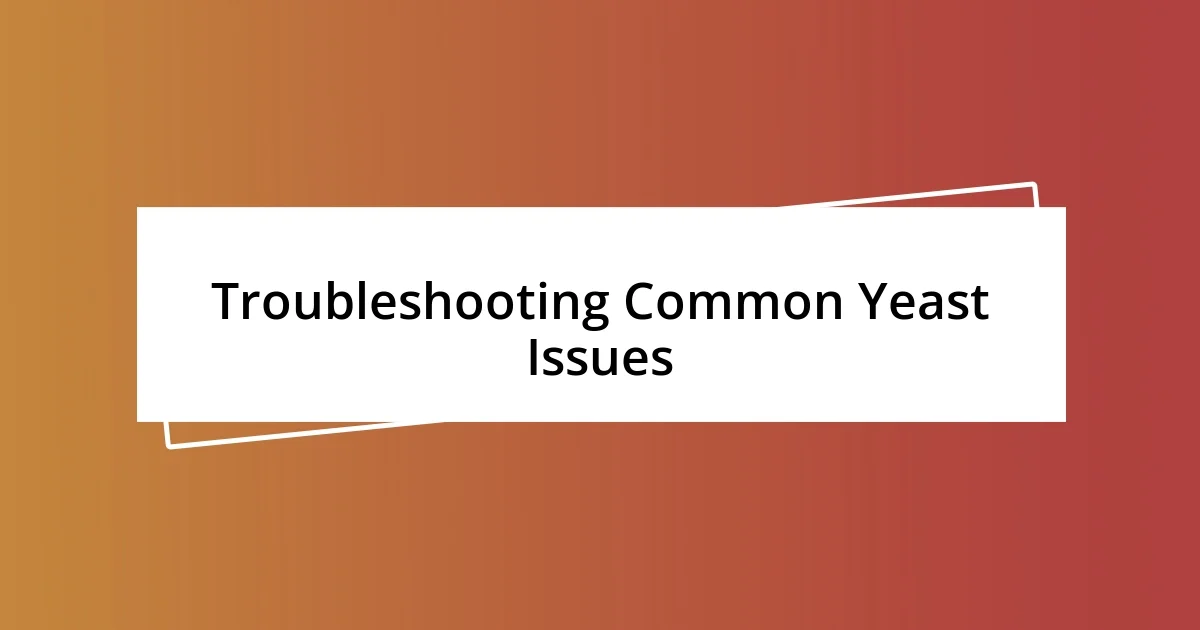Key takeaways:
- The type of yeast used in baking significantly affects the flavor, texture, and fermentation process of the final product.
- Understanding yeast biology, including its metabolic process and temperature sensitivity, is crucial for successful baking and brewing.
- Effective yeast use involves controlling ingredient temperature, allowing sufficient proofing time, and nurturing sourdough cultures for enhanced flavors.

Introduction to Yeast Types
Yeast is a fascinating microorganism that plays a crucial role in baking, brewing, and even winemaking. I still remember the first time I experimented with different yeast types in my kitchen; it was like opening a door to a world of flavors and textures. Have you ever wondered why certain breads have a distinct taste or texture? The type of yeast used can make all the difference.
From the classic active dry yeast to the more modern instant yeast, each type brings unique characteristics to the table. I found it intriguing how even the tiniest variation in yeast can affect fermentation times and rise. Also, there’s a whole realm of specialty yeasts, like sourdough starters, that not only contribute to leavening but also impart a delightful tanginess to the bread.
As I delved deeper into the different yeast types, I realized there’s more to it than just their baking characteristics. For instance, did you know that some yeasts are aerobic while others are anaerobic? That means some thrive in oxygen, while others don’t. This distinction can dramatically affect the outcome of your bread or beer. It’s a reminder of just how complex and wonderful the world of yeast really is!

Understanding Yeast Biology
Understanding yeast biology is essential for anyone delving into baking or brewing. I remember once trying to bake a simple bread using instant yeast after a mishap with active dry yeast. The difference was astounding; the rise and texture were completely transformed, making it quite clear that yeast isn’t just a mere ingredient—it’s a living organism with specific needs and behaviors.
Here are some key aspects of yeast biology to consider:
- Cell Structure: Yeast cells are unicellular fungi, meaning they consist of a single cell.
- Metabolism: Yeasts primarily metabolize sugar through fermentation, converting it into alcohol and carbon dioxide.
- Temperature Sensitivity: Different yeast types thrive at different temperatures, which influences their fermentation activity.
- Reproduction: Yeast can reproduce asexually by budding, a process that allows it to multiply rapidly under optimal conditions.
- Diversity: There are hundreds of yeast species, but Saccharomyces cerevisiae is the most commonly used in baking and brewing.
Understanding these elements has not only enriched my baking experience but also deepened my appreciation for this remarkable microorganism.

Common Types of Yeast
When exploring the common types of yeast, I’ve come to appreciate how distinct they really are. Active dry yeast is the classic choice for bakers. I remember using it for the first time; the way it came to life with just a bit of warm water felt almost magical. Instant yeast, on the other hand, is a modern marvel. I tried it in a last-minute pizza dough, and to my surprise, it significantly reduced my rising time while still achieving a delightful fluffiness.
Sourdough starter is another fascinating type of yeast. The first time I fed my starter, I felt a connection to centuries of baking tradition. Watching the bubbles appear and transform into a tangy, living culture was a reminder of how deeply rooted yeast is in our culinary history. There’s something incredibly satisfying about nurturing it, knowing that each batch contains wild yeast and bacteria, working together to create something delicious.
I often find myself curious about how these different yeast types interact with the ingredients around them. For example, wild yeast can give bread an earthy, robust flavor profile that commercial yeasts can’t replicate. I once baked a loaf using wild yeast from my garden; the taste was so unique that it prompted several friends to ask for the recipe. This diversity in yeast types truly opens up a world of flavors and experiences for any baker willing to explore.
| Type of Yeast | Key Characteristics |
|---|---|
| Active Dry Yeast | Must be hydrated before use; ideal for traditional baking. |
| Instant Yeast | Can be mixed directly with dry ingredients; faster rise time. |
| Sourdough Starter | A living culture that ferments over time; unique tangy flavor. |

Comparing Flavor Profiles
When it comes to flavor profiles, each type of yeast brings its own unique character to the table. For instance, when I first experimented with sourdough starter, the tangy depth that developed during fermentation surprised me. It was fascinating to discover how the wild yeast and bacteria created a complex flavor that you just don’t find with standard commercial yeasts. Who knew a little patience could reward you with such an overwhelming sense of satisfaction in both taste and tradition?
Active dry yeast often gives a cleaner, more straightforward flavor, perfect for basic bread that pairs well with most meals. I recall baking a loaf for a family gathering, where the subtle sweetness of the yeast complemented the savory toppings perfectly. It really made me appreciate how integral yeast is to the overall flavor profile of my creations. Shouldn’t we sometimes celebrate the classic choices, even if they seem simple?
Then there’s instant yeast, which has a slightly different nuance. In hurried moments, I’ve opted for instant yeast in quick recipes, and while it accelerates the process beautifully, it sometimes lacks the depth that slower fermentation brings. I remember making a pizza dough one night and noticing how the flavors weren’t as rich as I’d hoped. It made me reflect on how the journey of fermentation really adds layers to what we ultimately create. Isn’t it interesting how the type of yeast can change not just the texture, but the entire experience of what we’re baking?

Practical Baking Applications
Baking with different types of yeast opens up a fascinating world of possibilities. I remember the first time I used instant yeast in a quick dough recipe. The speed at which it activated was remarkable! However, after tasting the final product, I found myself longing for that deeper complexity that develops during a longer fermentation with active dry yeast. Isn’t it interesting how sometimes, the quickest route isn’t always the most satisfying?
Then there are those moments when I immerse myself in sourdough baking. Each time I open the jar of my starter, I’m greeted by that earthy aroma, reminding me of how diverse yeast can be. I once prepared a batch of dinner rolls using my starter, and the outcome was a game-changer. The subtle tanginess mingled beautifully with the buttery richness, creating a flavor that lingered in every bite. I’ve realized that allowing yeast to work its magic over time truly brings a sense of satisfaction, don’t you think?
I’ve also experimented with wild yeast, drawing inspiration from nature. While camping, I collected some wild yeast from fruit growing nearby. After a few days of nurturing it, I baked a rustic bread that surprisingly completed our outdoor feast. The bread had a unique flavor that sparked conversation—and even a few requests for the recipe! It reminded me just how vital a role the environment plays in our baking experiences. Have you ever had a moment where the ingredients around you transformed your creation in unexpected ways?

Troubleshooting Common Yeast Issues
When it comes to troubleshooting yeast issues, I’ve had my fair share of challenges. One time, I forgot to check the expiration date on my active dry yeast, leading to a loaf that barely rose. It was such a disappointment, especially since I was hoping to impress friends at a brunch. Now, I make it a ritual to always check if my yeast is still good—it’s a small step that saves a lot of heartache.
Another issue I’ve faced is what I call “the sluggish rise.” I remember baking bagels one rainy afternoon, and my dough just sat there. After some investigation, I learned that moisture can affect yeast activity. Curious about this, I found that adjusting the proofing environment really helped! I soaked a towel in warm water, covered my dough with it, and voila—it worked wonders! Doesn’t it feel great to troubleshoot and discover solutions for challenges?
Sometimes, I encounter that infamous “yeast smell” that hints my fermentation might’ve gone awry. I recall a batch of cinnamon rolls that was a total bust due to over-fermentation. The sweet, intoxicating aroma became an unpleasant odor. It was frustrating, but I learned to monitor my dough closely; timing can be everything. Have you ever had a moment where your baking led you to learn more than just about ingredients? It’s these experiences that enrich our culinary journeys and enhance our baking skills!

Tips for Using Yeast Effectively
One of the best tips I can offer for using yeast effectively is to control the temperature of your ingredients. In my early baking days, I often used cold water straight from the tap, thinking it wouldn’t matter. However, I quickly learned that warm water—not too hot, but cozy to the touch—helps yeast activate faster. Have you ever felt the rush of anticipation when you see those tiny bubbles forming? There’s something magical about seeing that transformation.
Another thing that’s been a game-changer for me is patience during proofing. I used to rush this stage, glancing anxiously at my dough as if willing it to rise. I’ve learned that a longer, slower rise can develop incredible flavors, especially with active dry yeast. One time, I decided to let my dough rest overnight in the fridge, and when I woke up, the aroma hit me instantly. That loaf had such depth and character—it was worth every extra hour of waiting. How often do we overlook the value of simply letting things be?
Lastly, I always make sure to feed my sourdough starter regularly. I remember the first time I neglected it for a week and ended up with a sad, lifeless blob. It taught me the importance of nurturing live cultures—much like any relationship in our lives. Regular feedings keep that robust activity going, allowing me to wake up to the delightful scent of fresh bread. Have you ever felt that connection with your ingredients? It’s those little rituals that truly transform baking from a task into a heartfelt passion.














